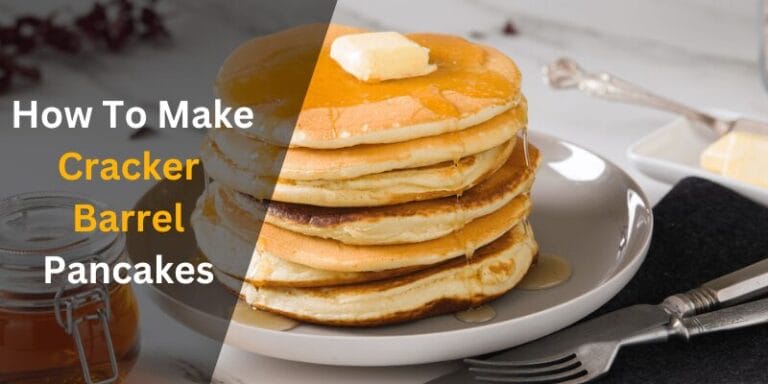Can You Make Pancakes Without Milk – No Milk, No Problem

You open the fridge to get the bottle of milk to make pancakes, only to realize you’ve run out. No need to stress! Making pancakes without milk is not only possible but also surprisingly simple.
Yes, you can make pancakes without milk. There are plenty of alternatives you can use, such as water, dairy-free milk (like almond milk or soy milk), or even fruit juice. These alternatives can work just as well as milk in your pancake batter, ensuring you can still enjoy delicious pancakes even if you’re out of milk or following a dairy-free diet.
Whether you’re lactose intolerant, following a dairy-free diet, or simply out of milk, there are various alternatives and substitutions available to ensure you can still enjoy delicious pancakes.
Let’s get started.
How To Make Pancakes Without Milk – An Easy Guide
Although there are numerous substitutes for milk when making pancakes, in this recipe, we opt for water as a simple and readily available alternative.
Ingredients For No Milk Pancakes:
Making pancakes without milk doesn’t require any special or hard-to-find ingredients. Here’s what you’ll need:
- All-Purpose Flour: The main dry ingredient in pancake batter, all-purpose flour provides structure and texture to your pancakes.
- Water: Used as a substitute for milk, water helps bind the ingredients together and creates a smooth batter.
- Eggs: Eggs add richness and help bind the ingredients together, resulting in fluffy pancakes.
- Sugar: Adds sweetness to the pancakes and enhances their flavor.
- Baking Powder: Provides leavening, helping the pancakes rise and become light and fluffy.
- Salt: Enhances the flavor of the pancakes and balances the sweetness.
- Oil or Butter: Used for greasing the cooking surface and adding flavor to the pancakes.
- Optional Flavorings: You can customize your pancakes by adding vanilla extract, cinnamon, or other flavorings to the batter according to your preferences.
Making Yummy Pancakes With Water
Making pancakes without milk is easier than you might think. You can substitute water for milk in your pancake recipe without sacrificing flavor or texture. Here’s how:
- Adjusting the Liquid: Instead of using milk, simply use an equal amount of water in your pancake batter. For example, if your recipe calls for 1 cup of milk, use 1 cup of water instead.
- Maintaining Consistency: When mixing the batter, you may notice that the consistency differs slightly from when using milk. This is normal. Keep mixing until all the ingredients are well combined and the batter is smooth.
- Cooking as Usual: Once your pancake batter is ready, cook your pancakes as you normally would. Use a hot, greased skillet or griddle and pour the batter onto the cooking surface to form pancakes of your desired size.
- Enjoying the Result: Once cooked, your pancakes will be fluffy and delicious, just like traditional pancakes made with milk. Serve them warm with your favorite toppings, such as maple syrup, fruit, or whipped cream.
With these simple ingredients and easy-to-follow instructions, you can whip up delicious pancakes without milk in no time. Enjoy your homemade pancakes for a delightful breakfast or brunch treat!
How Thick Should Pancake Batter Be?
Pancake batter should be thick enough to coat the back of a spoon but still pourable. It should have a smooth consistency that slowly drips off the spoon when lifted. If the batter is too thin, the pancakes may spread too much and become thin and flat.
On the other hand, if the batter is too thick, the pancakes may turn out dense and heavy. Adjust the thickness of the batter by adding more liquid (such as milk or water) if it’s too thick, or more flour if it’s too thin, until you achieve the desired consistency.
How Do You Get That Crispy Edge on Pancakes?
To get that crispy edge on pancakes, there are a few simple tricks you can try:
- Use Butter: Before pouring the pancake batter onto the griddle or skillet, melt a small amount of butter on the cooking surface. This will help create a golden, crispy edge as the pancake cooks.
- Don’t Overcrowd: Give each pancake enough space on the cooking surface. Overcrowding the pan can trap steam and prevent the edges from crisping up properly.
- Cook on Medium-High Heat: Use a medium-high heat setting to cook the pancakes. This helps to quickly brown the edges while keeping the inside fluffy.
- Patience is Key: Allow the pancakes to cook undisturbed until bubbles form on the surface and the edges start to look set. This indicates that it’s time to flip the pancakes and cook the other side until golden brown.
By following these tips, you can achieve that irresistible crispy edge on your pancakes, adding an extra layer of texture and flavor to your breakfast delight!
Conclusion
In conclusion, making pancakes without milk is not only possible, it’s a common scenario for many people. Whether you forgot to pick up milk at the store or you’re accommodating someone with dietary restrictions, there are plenty of alternatives available. By using ingredients like water or dairy-free milk substitutes, you can still whip up a batch of delicious pancakes that everyone can enjoy. So next time you find yourself without milk, don’t worry – you can still make pancakes that are just as tasty and satisfying.
FAQs
Will using a milk substitute affect the taste and texture of the pancakes?
Yes, using a milk substitute can slightly alter the taste and texture of the pancakes, but it generally won’t drastically affect the outcome.
What is a substitute for milk in pancakes?
Common substitutes for milk in pancakes include water, almond milk, soy milk, coconut milk, or even fruit juice.
Does all pancake mix have milk?
No, not all pancake mixes contain milk. Some pancake mixes are designed to be mixed with water or a milk substitute, while others may require the addition of milk or eggs.
Are there any tips for making pancakes without milk to ensure they turn out fluffy and delicious?
Yes, some tips for making fluffy pancakes without milk include using a milk substitute with a similar consistency, ensuring the batter is not overmixed, and cooking the pancakes on a well-greased griddle or skillet over medium heat.
Can I use almond milk or soy milk in place of regular milk for pancakes?
Yes, almond milk, soy milk, and other non-dairy milk alternatives can be used in place of regular milk for pancakes. Just ensure to use an unsweetened variety to avoid overly sweet pancakes.






